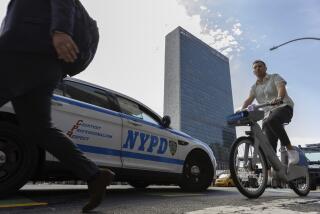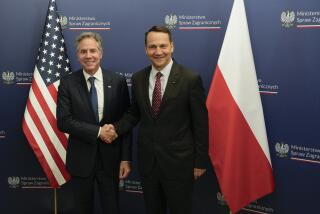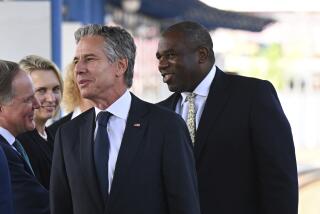Allies Gather in Geneva, at U.N. to Weigh Iraq Moves
UNITED NATIONS — As Secretary of State Madeleine Albright and other top diplomats met Wednesday to consider a Russian plan to end the standoff with Iraq, the U.N. Security Council here was advised that Iraqi President Saddam Hussein has had the time and ability to stock up on chemical- and germ-warfare weapons in the three weeks he has been blocking U.N. disarmament inspections in his country.
In a briefing for the council, representatives of the U.N. commission charged with eliminating Iraq’s weapons of mass destruction reviewed evidence of Iraq’s capacity to rapidly produce mustard gas, a chemical agent used in World War I, and anthrax, a biological weapon.
With inspections on hold since Oct. 29, officials said, there is no way of knowing whether the Iraqis have done so. However, the commission estimated that the Hussein government could produce 350 liters--about 92 gallons--of anthrax a week. That’s enough to fill two missile warheads or four bombs.
Commission staffers, led by Chairman Richard Butler of Australia, also discussed Iraq’s potential for manufacturing long-range missiles that could deliver warheads as far as Europe, its failure to fully account for at least 4 tons of the deadly nerve gas VX and the program of concealment the Iraqis have used to hide these activities from the inspectors.
The council session went forward as Albright cut short her visit to India and flew through the night for the meeting in Geneva with her Russian, British and French counterparts at 2 a.m. today. On the table was Russian Foreign Minister Yevgeny M. Primakov’s proposal to end the confrontation between Iraq and the United Nations. The plan was worked out Monday in a meeting between Russian President Boris N. Yeltsin and Iraqi Deputy Prime Minister Tarik Aziz in Moscow.
Details of the Russian plan were not made public. But Sergei V. Lavrov, Russia’s U.N. envoy, said it would require Iraq to permit U.N. weapons inspectors to resume their work “unconditionally and in full.” That would include readmitting the American inspectors ejected from Iraq last Thursday, an action that led to the withdrawal of almost all remaining inspectors and heightened the current confrontation.
But Lavrov also suggested the resumed inspections would lead to “accelerated” completion of the commission’s disarmament work and the lifting of economic sanctions against the Hussein regime. A rapid lifting of the sanctions is a principal goal of the regime and of Russia, which is eager to complete billions of dollars worth of oil deals linked to the end of the embargo.
*
Under terms of the U.N. resolution ending the 1991 Persian Gulf War, sanctions cannot be ended until U.N. weapons inspectors certify that Iraq no longer can wage nuclear, chemical or biological warfare and that it has destroyed all its long-range missiles. The cease-fire also provides for long-term monitoring to ensure Iraq does not reacquire proscribed weapons.
Lavrov declined to discuss how the disarmament might be accelerated. But Russia and France have suggested that sanctions might be lifted in stages. For example, agreement that all of Iraq’s long-range missiles have been destroyed could lead to an easing but not an elimination of the embargo.
But the United States and Britain have rejected that approach. En route to Geneva, Albright signaled that she would be taking a hard line in the talks.
“Iraq must let the weapons inspectors get back to their vital work of preventing Iraq from building nuclear, chemical or biological weapons, and it must permit those inspections to proceed without interference or conditions,” she said during a stop in Cairo. “Nothing that comes short of that is acceptable.”
She also said that while the United States hopes to achieve this objective peacefully, “we cannot rule out other options.”
There also was more tough talk in Washington on Wednesday. President Clinton stressed that, although his administration wants to find a peaceful resolution to the standoff with Baghdad, he will not compromise with Hussein, even if it leaves no alternative but military action.
“Iraq must comply with the unanimous will of the international community and let the weapons inspectors resume their work to prevent Iraq from developing an arsenal of nuclear, chemical and biological weapons,” Clinton said at the White House as he signed a bill easing rules on adoptions. “That’s our top line. That’s our bottom line.”
Clinton appeared to be trying to prepare the public for possible military action. “I do not want these children we are trying to put in stable homes to grow up into a world where they are threatened by terrorists with biological and chemical weapons,” Clinton said. “It is not right.”
The current impasse grew out of an Iraqi announcement Oct. 29 that the Persian Gulf nation would stop cooperating with U.N. inspections until all Americans participating in the program were removed and flights by an American U-2 reconnaissance plane on loan to the U.N. were halted. Iraq says it has destroyed all its prohibited weapons and accuses the U.S. of manipulating the inspections to ensure that sanctions will never be lifted and of using the operation as a cover for spying.
The differences among the Gulf War allies about how to deal with the crisis highlights a fundamental divide among four of the core members of the 34-nation coalition that defeated Iraq.
When it comes to getting Hussein to cooperate with the destruction of his illegal weapons, Russia and France believe he can be enticed with incentives. The U.S. and Britain think he must be pushed with sanctions--and sometimes with military force.
Moreover, the United States has said it does not favor lifting sanctions as long as Hussein maintains his hold on power. Albright pronounced that policy goal in a pivotal speech last spring after years of inferences by her predecessors.
The Clinton administration links the lifting of sanctions not only to Iraqi weapons destruction but to U.N. resolutions calling for Baghdad to honor human rights. And as long as Hussein is in power, U.S. policymakers contend, human rights and democratic principles are unlikely to be recognized.
Washington and London also remain deeply suspicious of any of Iraq’s representations to the weapons inspectors. The U.N. inspectors consistently have trapped the Iraqis in lies and cover-ups about its weapons programs.
Much of that record was repeated by disarmament specialists Wednesday in their presentation to the Security Council. U.S. Ambassador Bill Richardson called it “a consistent pattern of Iraqi concealment.”
In response to a request by Lavrov, the Russian ambassador, Butler and nine technical assistants--four Americans, two Germans, a Russian, a Frenchman and a Dutchman--gave a methodical review of what the disarmament commission has learned, as well as what remains hidden or unknown.
They illustrated their talks with large graphs and charts and oversized photographs. One picture, taken by the U-2, illustrated how the commission uses the spy plane to photograph the shell game Iraq sometimes employs by using truck convoys to move prohibited equipment or documents from one building to another one step ahead of inspectors on the ground.
At a news conference afterward, Butler declined to estimate how far behind the inspectors might be as a result of their withdrawal late last week, but acknowledged that “as each day passes, the degree of difficulty [catching up] increases.”
Most of the information presented was included in the commission’s previous written reports, but one participant said the review “concentrates the mind as far as what’s still out there.”
But a source present said the differences on the council were evident as the French and Russian representatives sought during questioning of Butler to highlight areas where the commission has made the most progress and received the most cooperation from Iraq; the Americans tried to underline the problems.
Among the first charts shown to the council was a map with concentric circles radiating out from Iraq. The circles represented the range of missiles that at one time or another have been in Iraq’s military plans. Among the cities shown on the map as within missile range were Moscow and Paris.
*
Turner reported from the United Nations and Wright from Cairo. Times staff writer Elizabeth Shogren in Washington also contributed to this report.
(BEGIN TEXT OF INFOBOX / INFOGRAPHIC)
Troop Update
A look at the growing U.S. presence in the Persian Gulf.
* 50 aircraft and 1,000 personnel based in Incirlik, Turkey
* 1,500 Army personnel based in Kuwait
* 6,000 Air Force personnel based at Prince Sultan Air Base, Saudi Arabia
* 22,000 Navy and Marine personnel
Navy: At least 24 ships, including the aircraft carriers Nimitz and George Washington
Marines: 2,100 Marines and sailors of the 13th Marine Expeditionary Unit aboard the Peleliu, Juneau and Comstock
More to Read
Sign up for Essential California
The most important California stories and recommendations in your inbox every morning.
You may occasionally receive promotional content from the Los Angeles Times.









